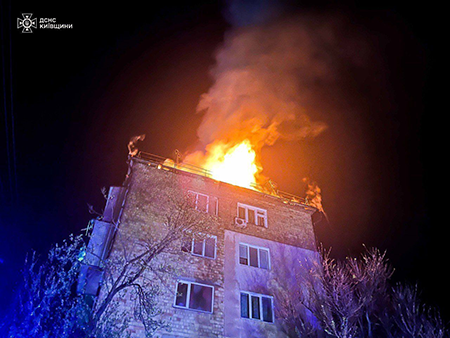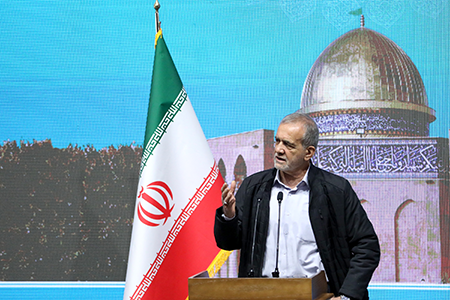"I greatly appreciate your very swift response, and your organization's work in general. It's a terrific source of authoritative information."
A Stress Test for the NPT
May 2025
By Adam Scheinman
The global nuclear Nonproliferation Treaty (NPT), negotiated in the 1960s with U.S. and Soviet backing and coordination, and extended indefinitely several years after the Cold War collapsed, is among the most significant achievements of the post-World War II period. Absent an NPT, nuclear weapons almost certainly would have spread more widely, international regimes governing nuclear-energy use may never have emerged, and the now 80-year record of nuclear weapons nonuse may not have held for as long as it has.

But can the treaty and the nonproliferation system continue to hold? Even before U.S. President Donald Trump’s election in November, the NPT was coping with the stresses of a rapidly changing global security environment, punctuated by Russia’s illegal full-scale war in Ukraine and China’s growing military power and race to nuclear parity with Russia and the United States. Post-election, those stresses are certain to intensify, especially for the NPT states most vulnerable to nuclear or military aggression.
Given the stakes for global safety and security, defenders of the NPT will need to insulate the treaty and shore up support. If approached as a utilitarian exercise, that is, by aiming to maximize NPT benefits and minimize nuclear risks, treaty parties may yet find it possible to protect the nonproliferation system, even with the tide seeming to be running against it.
Rising Pressures
Making confident predictions about the impact of Trump’s policies on the NPT is challenging, to say the least. This is due in part to his personalist and transactional style, but equally because the new administration has yet to articulate a strategic direction apart from tariff policy and a default to “America First,” which seems more slogan than grand strategy. Uncertainties notwithstanding, there are nonproliferation impacts that bear close watching, including with respect to the nuclear defense of allies, the future course of Iran’s nuclear program, and prospects for arms control.
To be sure, the NPT is not without its defects. Not all nuclear weapon possessors are parties to the treaty and the track record for enforcing compliance, as seen in the cases of Iran and North Korea, is not entirely inspiring. Nor is the NPT immune from deep disagreements among parties on core treaty priorities and obligations, particularly the issue of nuclear disarmament. But those disagreements are largely political and do not threaten the NPT’s future or viability in the way that Russia’s illegal invasion of Ukraine and its ambition to replace the international rules-based order with one organized along spheres of influence could. Regrettably, Trump’s seeming sympathy for this Russian ambition may signal not only a loss of historic U.S. leadership in the NPT, but also a non-trivial risk of states opting for nuclear weapons,1 or positioning themselves to acquire such weapons quickly, if the NPT or the United States fail to deliver security from nuclear threats or military aggression.
The warning signs are already flashing red. Trump’s decision to negotiate a ceasefire with Russia over the head of Ukraine’s leaders has clearly unnerved allies who rely on U.S. extended nuclear deterrence. In Europe, the credibility of that deterrence rests not only on a small number of U.S. air-delivered nuclear weapons forward-based in several NATO countries, but a shared understanding that any nuclear war in Europe may well escalate to employment of U.S. strategic nuclear forces. Who in Europe, especially states on Russia’s frontier, perceives such unity of commitment today? Recent discussions on options for a “Euro-deterrent”2 are an indication that many do not.
Despite U.S efforts across multiple administrations to deepen extended nuclear deterrence commitments, it is not a stretch to imagine Japan or South Korea also opting for independent national nuclear weapons programs if their publics lose faith in U.S. nuclear guarantees to deter China and North Korea, which are rapidly expanding their nuclear weapons and missile forces. The military case in Seoul or Tokyo for proliferation will naturally strengthen if the credibility of U.S. nuclear deterrence is in doubt.
Because China does not wish to see NATO’s nuclear sharing arrangements replicated in Asia, it uses the NPT review process to amplify the false claim that the treaty does not allow for such arrangements.3 China has proven adept at using this issue to embarrass U.S. allies and exploit disarmament frustrations shared by many in the Global South. Notwithstanding the obvious contradictions given China’s increasing reliance on nuclear weapons, it should be anticipated that Beijing will keep this issue high on the NPT agenda considering Trump’s obvious discomfort with alliances.
 A more immediate threat to the NPT is the future direction of Iran’s nuclear program. A decision by Iran to leave the treaty could trigger a crisis if Saudi Arabia, Egypt, and perhaps others follow Iran out the door on the grounds that the treaty no longer works for them. Moreover, the prospect of an Iranian nuclear breakout may invite Israeli or U.S. military preemption, which in turn would generate risks of a regional war. Adding greater urgency, Iran’s breakout time to develop a deliverable nuclear weapon has dropped precipitously since 2018 when Trump pulled the United States out of the 2015 nuclear deal known as the Joint Comprehensive Plan of Action.
A more immediate threat to the NPT is the future direction of Iran’s nuclear program. A decision by Iran to leave the treaty could trigger a crisis if Saudi Arabia, Egypt, and perhaps others follow Iran out the door on the grounds that the treaty no longer works for them. Moreover, the prospect of an Iranian nuclear breakout may invite Israeli or U.S. military preemption, which in turn would generate risks of a regional war. Adding greater urgency, Iran’s breakout time to develop a deliverable nuclear weapon has dropped precipitously since 2018 when Trump pulled the United States out of the 2015 nuclear deal known as the Joint Comprehensive Plan of Action.
This year will be critical for the Iran nuclear issue, and therefore for the NPT. In February, Trump signed a national security memorandum restoring “maximum pressure” on Iran; more recently, he announced support for a diplomatic resolution if it can prevent Iran from acquiring a nuclear weapon. Given recent setbacks to Iran’s security position in the region, Tehran presumably has an incentive to explore a bargain. For his part, Trump will not be burdened with opposition in the Republican-controlled Congress as President Barack Obama was in 2015. With full international sanctions set to “snap back” on Iran in October, the clock on a solution is ticking.4
Stabilizing the NPT
The second Trump administration inherits an NPT regime that is working but faces significant headwinds. Beyond familiar disagreements on disarmament or a Middle Eastern WMD-free zone (which for some parties is a proxy to pressure Israel), Russia’s war in Ukraine and its grossly negligent nuclear conduct—from threats of nuclear-weapons use to its armed seizure of a Ukrainian nuclear power plant—collapsed all forms of cooperation between Russia and West. Notably, this has included a political level dialogue among the treaty’s five recognized nuclear-weapon states (China, France, Russia, the United Kingdom, and the United States) to coordinate on NPT matters. It would be preferable if the five states returned to dialogue and cooperation on the NPT, but this likely remains out of reach absent a settlement in Ukraine.
In the interim, the window is open for other leading NPT voices to advance an agenda to stabilize the treaty and encourage future dialogues and agreements. This “stabilizers” group should include states from across the political spectrum that are willing to set aside narrow political agendas and keep focus on the NPT’s higher purpose, which as stated in its first preambular paragraph is to avert the “devastation that would be visited upon all mankind by a nuclear war.”

Taking this as direction, the group should give priority to a range of nuclear arms control and risk reduction measures that, while not new to the NPT process, are urgently needed. This could include a U.S.-Russian agreement to hold to the New Strategic Arms Reduction Treaty numerical caps and restore verification until a new deal with China and Russia, which Trump has said he favors,5 can be discussed.
This approach also could cover confidence-building measures to limit risks of inadvertent military escalation, such as agreements on transparency and crisis management and prevention, as well as restraints on nuclear weapons testing and fissile material production. The five nuclear-weapon states, for instance, could commit collectively not to be the first to resume nuclear testing and to address concerns surrounding activities at nuclear test sites, which is the minimum necessary for U.S. ratification of the Comprehensive Test Ban Treaty. They also could consider alternative frameworks to the Conference on Disarmament for agreement among all nuclear possessor states to cut off production of fissile material for weapons use.
Realistically, the scope for agreement even on this agenda is narrow and contingent on much falling the right way, such as avoiding a U.S. break with allies over trade or defense or the renewal of open-ended nuclear arms racing. In addition, there is simply not sufficient time to make much progress on a “stabilizer” program between now and the 2026 NPT Review Conference. Rather than overload the circuits, the state-parties instead could set goals in 2026 to be assessed or updated in 2030.
To broaden support and enhance credibility, a program of stabilizing the NPT would need to extend to all aspects of the treaty, including a commitment of the advanced economies to facilitate the anticipated expansion of peaceful nuclear energy and science. With new, more affordable, small modular reactor designs ready to hit the market, this is the time to ensure that the transition to nuclear energy meets the highest standards for nuclear nonproliferation, safety and security. Given that all five NPT-recognized nuclear-weapon states are major nuclear suppliers and share an interest in preventing new proliferation, coordination on this topic also could be expected if and when the governments are ready to resume their political-level dialogue.
Skeptics of this overall approach will argue that it lacks ambition or represents a step back from prior commitments relating to nuclear disarmament. In fact, progress on a stability agenda would be a step back from the brink and a return to principles and practices of nuclear restraint. Given the stakes, states should be encouraged to set aside disarmament theology and approach the NPT from a utilitarian perspective, aiming to reduce nuclear weapons dangers at a time of transition in the global order. Knowing from history that not all such global transitions ended peacefully, one can only hope that the treaty’s leading members are up to the task.
ENDNOTES
1. Ankit Panda, Vipin Narang, and Pranay Vaddi, “Nuclear Proliferation Will Haunt ‘America First,’” War on the Rocks, March 10, 2025.
2. Ankit Panda, “France, UK must heed the call of Europe’s new nuclear age,” Defense One, March 20, 2025.
3. William Alberque, “The NPT and origins of NATO’s nuclear sharing arrangements,” Institut Francais des Relations Internationales, Proliferation Papers, No. 57 (February 2017).
4. Michelle Nichols, “Explainer: How UN sanctions on Iran could be restored,” Reuters, April 10, 2025.
5. Zeke Miller and Michelle L. Price, “Trump wants nuclear arms talks with Russia and China,” Defense News, February 13, 2025.
Adam Scheinman was the special representative of the president for nuclear nonproliferation, with the rank of ambassador, in the Biden and Obama administrations.
